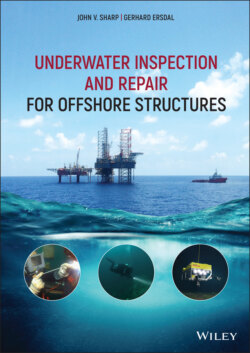Читать книгу Underwater Inspection and Repair for Offshore Structures - Gerhard Ersdal - Страница 36
2.4.2 API RP‐2MIM (Mooring Integrity Management)
ОглавлениеAPI RP‐2MIM (API 2019b) is a recommended practice (RP) providing guidance for the integrity management of mooring systems connected to permanent floating production systems (FPS). The scope covers the system from the anchor to the connection to the floating unit. The guidance provided covers inspection, monitoring, evaluation of damage, fitness‐for‐service assessment and mitigation planning. This RP includes guidance from API RP‐2I (API 2008) and API RP‐2SK (API 2005) and expands on both of these. The RP allows risk‐based principles to be used to develop an appropriate strategy, with higher risk moorings requiring more frequent inspections than lower risk moorings.
The integrity management plan defines two approaches, which are prescriptive and risk based. For the prescriptive method the operator is referred to the requirements specified in API RP‐2I (API 2008) or API RP‐2SK (API 2005). A risk‐based approach should be developed in terms of the potential risk of damage to the component being inspected. The inspection plan outlines the frequency and scope of the inspections, the tools to be used and how these will be deployed. Inspection techniques are listed in an annexe to the RP and include a comprehensive set covering all aspects of the mooring system, including the anchor, CP system, chain, coatings. The techniques listed include GVI, CVI, high resolution 3D photography, physical measurements and the use of an inclinometer.
API RP‐2MIM (API 2019b) recommends monitoring of the mooring system to continouosly verify its condition and performance. This may include direct measurements of the mooring response (e.g. line tension, strains) or measures than can indirectly predict mooring response such as vessel offset. Data from a position‐monitoring system can be used to ascertain that the mooring system is meeting design requirements. Environmental monitoring may also be used to provide metocean data to support the position monitoring. Monitoring for individual line performance is also useful to detect a line failure or loss of tension in the mooring system.
API RP‐2MIM (API 2019b) recommends determining assessment initiators, based on a change of condition outside the limits of the original design basis or from a recent in‐service assessment. Possible assessment initiators could result from, for example, damage, changes in station‐keeping performance and stability. To demonstrate an acceptable risk level for the mooring system, the likelihood of failure can be estimated by the use of a suitable risk assessment method for several different cases. These range from as‐originally‐designed to the as‐is‐condition using current design criteria. For the risk acceptance criteria, pre‐requisites are listed including defining mooring system failures and acceptable risk levels and demonstrating acceptable levels for the as‐is or planned configurations using the results from the previous analyses. If a mooring system does not pass the fitness for service criterion, risk reduction measures that reduce risk to an acceptable level are required. These measures can include changed operational procedures and modifications to the system. In addition, modifications to inspection and monitoring programs can be implemented to identify any further deterioration and reducing the likelihood of any undesired consequences.
Unlike other integrity management standards, API RP‐2MIM (API 2019b) addresses emergency response planning based on unexpected failures of a mooring system. Single line failure can escalate to multiple line failure quickly, requiring a range of options to be considered to develop a response plan. API RP‐2MIM (API 2019b) recommends that at least a short‐term emergency response plan should be in place before operations commence. In addition, there is a requirement for an immediate operational response plan. This immediate response plan needs to provide operators with a set of operating procedures that address a range of reasonably foreseeable situations that could occur both under normal and severe weather conditions. Actions arising from the plan could include ceasing production or limiting operations with defined limits.
API RP‐2MIM (API 2019b) recommends that a conservative approach is adopted until the nature of the failure is understood and any escalation ruled out. Inspections can be undertaken to provide information of the degradation mechanism to be identified. This then allows an assessment to be made of the potential for multiple degradation mechanisms to exist, which would affect the emergency response planning.
The short‐term plan should include procedures to address situations of substantial or imminent loss in mooring capacity, requiring emergency repairs to be made to the degraded mooring system sufficient to create the necessary time for a more permanent repair.
The medium‐term emergency response could entail a complete repair of the mooring system, eliminating the recorded degradation mechanism. It is recognised that there may be an intervening period between the inspection finding and the short‐term repair response during which the mooring system could operate in a degraded state, where accepted procedures for stopping operations and production shutdowns depending on the observed degree of degradation are needed.
Overall, API RP‐2MIM (API 2019b) is a comprehensive document relating to the integrity management of mooring systems and the only (to the knowledge of the authors) integrity management standard that includes a proper guidance for incident response planning and execution.
